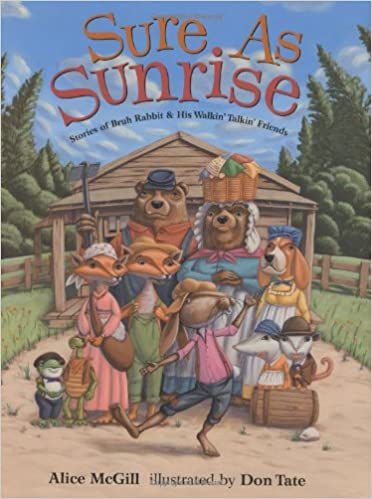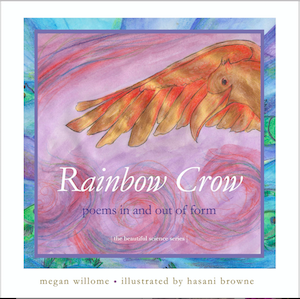My elementary school library had a loft called the Eagle’s Nest where a librarian or teacher would read aloud to us. One day the superintendent came and read us Brer Rabbit stories as told by Joel Chandler Harris in his 1880 bestseller Uncle Remus: His Songs and Sayings. It was my first introduction to the timeless trickster rabbit.
Harris, a reporter, worked for a publisher in Georgia and learned these stories from the enslaved men and women at his employer’s plantation. These stories have been told by many authors. Even Margaret Wise Brown wrote them with her slant in 1941. This version collects five stories written by Alice McGill and illustrated by Don Tate, who are both Black. I think it makes a difference.
There are five Bruh Rabbit stories in Sure As Sunrise: “Please Don’t Fling Me in the Briar Patch,” “Bruh Possum & the Snake,” “How the Critters Got Groceries,” “Bruh Rabbit’s Mystery Bag,” and “Looking to Get Married.”
The introduction alone is worth the price of the book. McGill says she first heard these stories from her neighbor, Neptune Clark, known as Mister Nep. It was not until she was an adult that she learned about the tales’ origins:
I learned later that during and after the middle passage of enslaved Africans, Bruh Rabbit became a spokesperson for these oppressed people. Hailing from Africa as Waikama, a hare, he dared to defy the king under his new title, ‘Bruh Rabbit.’ This little character adapted to new surroundings, and the enslaved could express their hopes and disappointments through his wit and trickery.”
Reading these tales, both the familiar and the new-to-me, I was reminded how funny they are. In the introduction to “Bruh Rabbit’s Mystery Bag,” McGill writes, “When I was a child Bruh Rabbit made me think a good trick was the same as a good laugh.” The story “How the Critters Got Groceries” made me laugh out loud, with its repetitions of “HERE HE COME AGAIN, Y’ALL!” and “IS IT DEEP ENOUGH?”
When I was a child listening to these stories in the library, I did not appreciate that Bruh Rabbit’s world is fundamentally unjust, filled with fickle kings and snakes with deadly fangs and snarling hounds hot on his trail. Trickery is all he has.
Reading these stories as an adult, I couldn’t help but think of another tricky hero, Odysseus. Extraordinary situations — Sirens, systemic racism — call for a little misdirection.
Bruh Rabbit’s adventures are portrayed in all their wily glory with Don Tate’s illustrations. Each one looks like a still from an animated movie, and each animal’s character shows on his or her face or in the way they appear to move, even in a static illustration. That vibrancy may stem from Tate’s technique of first making clay models of his characters, then painting them using oil and acrylic.
While I was hanging out in the briar patch with Bruh Rabbit, racial unrest was again sweeping the country. In the three weeks following the killing of George Floyd, The Slowdown replayed episodes containing poems about social justice, a total of fifteen in a row. Here is the message from former U.S. Poet Laureate Tracy K. Smith that accompanied each re-airing.
June 1, 2020
A message from TracyFor the remainder of this week, we’ve chosen to replay episodes that take up questions of social justice. The outrage and heartbreak brought on by the murders of George Floyd, Ahmaud Arbery, Breonna Taylor and other black citizens remind us that courageous dialogue about racial prejudice is critical to the survival of our culture. And we believe that poetry is a perfect vehicle for just such dialogue.
Because I have listened to every episode of the podcast since it aired, I’d already heard every poem, but hearing them again, day after day, week after week, was hard. It was also instructive. A lot of people in this country don’t get a break from the horrors of social injustice. Why should I?
Bruh Rabbit & His Walkin’ Talkin’ Friends never get a break either — only the ones they make for themselves. Whatever challenge they face, they are always victorious. Sure as sunrise.
_______________
The next Children’s Book Club will meet Friday, September 11. We’ll read Nine, Ten: A September 11 Story, a novel about four middle-schoolers by Nora Raleigh Baskin, in honor of the nineteenth anniversary of 9/11.
Photo by sagesolar, Creative Commons, via Flickr. Post by Megan Willome.
Browse more Children’s Book Club
“Megan Willome has captured the essence of crow in this delightful children’s collection. Not only do the poems introduce the reader to the unusual habits and nature of this bird, but also different forms of poetry as well.”
—Michelle Ortega, poet and children’s speech pathologist
- Perspective: The Two, The Only: Calvin and Hobbes - December 16, 2022
- Children’s Book Club: A Very Haunted Christmas - December 9, 2022
- By Heart: ‘The night is darkening round me’ by Emily Brontë - December 2, 2022




Leave a Reply